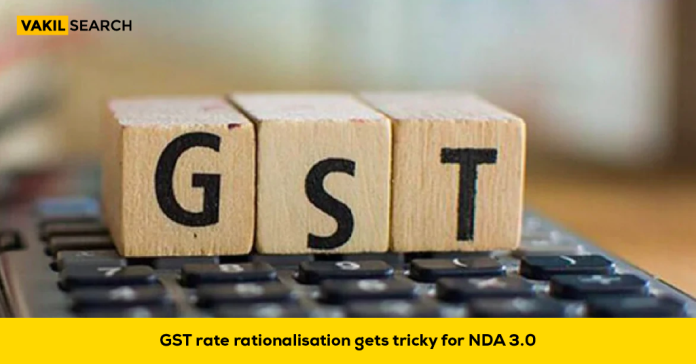New Delhi: The BJP-led government faces a tough task in implementing GST rate rationalisation following a reduced mandate in the Lok Sabha elections. Analysts warn this could impact poorer sections, a concern the government can’t afford to ignore.
A Group of Ministers (GoM) is set to explore consolidating the current four GST slabs into three. Experts caution that altering GST rates on semi-essential items, taxed at 12% or 18%, might increase the tax burden on essential goods, currently taxed at 5%.
Sources close to the development told Moneycontrol that rate rationalisation might not occur soon due to its potential negative impact on lower-income groups. The government’s challenge is to avoid dissatisfaction among rural and lower-income sections, especially after the election results. This issue will be discussed in the 53rd GST Council meeting.
Current GST Structure
Essential and semi-essential goods, making up 70-80% of India’s consumption, are taxed at 5% or 12%. Luxury items face a 28% tax, significantly contributing to government revenue. ‘It’s like a cross subsidy; if rates are rationalised, the government’s revenue may take a hit, but lower-income groups will be more impacted,’ sources stated.
The GoM, led by UP Finance Minister Suresh Khanna, is yet to finalise recommendations. Central Board of Indirect Taxes and Customs (CBIC) Chairman Vivek Johri aims to streamline the current GST rates into three.
Potential Rate Adjustments
Consolidating four rates into three could involve merging slabs, possibly creating an 8% or 15% rate. Abhishek Jain, Partner & National Head of Indirect Tax at KPMG, explains, ‘At 8%, items like edible oil could go from 5% to 8%, impacting lower-income groups.’ Rationalising services taxed at 18% to 15% might reduce government revenue, necessitating an increase in the 12% rate, likely affecting semi-essential goods and services.
Role of States
In the GST Council, the Centre holds one-third of the votes, while states hold two-thirds. States’ consumption patterns will significantly influence policy decisions. Regional parties may push for lower rates in categories based on their consumption patterns, leading to gradual changes rather than immediate consolidation.
Impact on Businesses
Prateek Bansal, Tax Partner at White and Brief – Advocates & Solicitors, warns that reclassification will cause market disruptions, resetting business operations and impacting the ease of doing business. The multiplicity of tax rates has led to classification disputes and legal issues, with similar items taxed differently across states.
Tax experts call for GST simplification to reduce compliance problems and legal disputes. Examples of classification issues include varying tax rates on packaged vs. unpackaged goods and disputes over rates for similar products.
Conclusion
The GST classification system’s complexity, with multiple tax rates, creates tax uncertainty for businesses. Simplifying GST rates into a three-slab structure would provide clarity and reduce interpretational issues. However, balancing revenue needs with the impact on lower-income groups remains a significant challenge for the NDA government.



